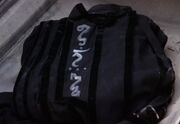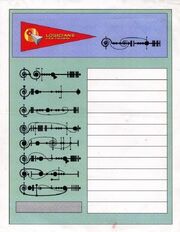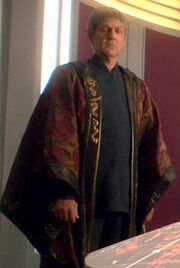Capncanuck (talk | contribs) |
m (r2.7.5) (Bot: Adding fr:Vulcain (langue)) |
||
| (37 intermediate revisions by 15 users not shown) | |||
| Line 1: | Line 1: | ||
[[File:Vulcan_scripts.gif|thumb|Six variations on the Vulcan script]] |
[[File:Vulcan_scripts.gif|thumb|Six variations on the Vulcan script]] |
||
| − | The '''Vulcan [[language]]''' |
+ | The '''Vulcan [[language]]''' was spoken by the [[Vulcan]]s of the [[planet]] {{dis|Vulcan|planet}}. |
| + | |||
| + | Vulcan names used among non-Vulcans were, at best, only approximations of actual Vulcan names; correct pronunciations using non-Vulcan phonemes, and accurate type-setting using, for perhaps the best example, the Roman alphabetical nucleus of the English language, of Vulcan family names had a tendency to defy non-Vulcan efforts to do either. ({{TOS|This Side of Paradise|Journey to Babel}}, et al.) |
||
==Written language== |
==Written language== |
||
| − | [[File:Vulcan writing ancient - pjem.jpg|thumb|Ancient Vulcan text]] |
+ | [[File:Vulcan writing ancient - pjem.jpg|thumb|left|Ancient Vulcan text]] |
| − | [[File: |
+ | [[File:Vulcan burial robe.jpg|thumb|[[Spock]]'s burial robe in his coffin]] |
| − | The Vulcan written language |
+ | The Vulcan written language had several different forms, some of which combined with each other. |
| − | The primary version |
+ | The primary version resembled [[Human|terrestrial]] [[music]]al notes and was written in vertical columns running top-to-bottom, left-to-right. The primary Vulcan script consisted of a central staff, along which spirals, long and short dashes, and dots were written. ({{ENT|The Seventh}}) |
| + | [[File:Logicians score card.jpg|thumb|Score sheet used by the Logicians in their baseball game against the [[Niners]]]] |
||
| ⚫ | |||
| + | In [[2375]], the [[Logicians]], a [[Baseball]] team founded by Captain {{dis|Solok|Captain}} of the [[USS T'Kumbra]], wore uniforms with their names on the back in Vulcan script. ({{DS9|Take Me Out to the Holosuite}}) |
||
| ⚫ | |||
| ⚫ | |||
| ⚫ | |||
| ⚫ | A second writing system |
||
| ⚫ | A second writing system consisted of simple squiggles, spirals, and dots and could be used separately or in tandem with the primary script. A sequence of several symbols from this script appeared on many forms of Vulcan clothing. This script was also written vertically. ({{film|1}}; {{film|4}}; {{ENT|Breaking the Ice|Fusion|Stigma|Awakening}}, ''et al.'') |
||
| ⚫ | |||
| + | |||
| ⚫ | |||
A dreidel-like children's toy (seen on [[Romulus]]) bore the "syllabic nucleus of the Vulcan language." ({{TNG|Unification II}}) |
A dreidel-like children's toy (seen on [[Romulus]]) bore the "syllabic nucleus of the Vulcan language." ({{TNG|Unification II}}) |
||
| − | |||
| − | Vulcan script appears on Spock's funeral robe. ({{film|3}}) |
||
==Examples of spoken language== |
==Examples of spoken language== |
||
| + | ;Pon farr |
||
| + | :''time of mating'' |
||
| + | |||
;Koon-ut-kal-if-fee |
;Koon-ut-kal-if-fee |
||
:''Marriage or challenge'' |
:''Marriage or challenge'' |
||
| + | |||
| + | ;Kar-i-far |
||
| + | :''Begin'' |
||
;Kroykah |
;Kroykah |
||
| Line 58: | Line 67: | ||
:''Live long and prosper, Spock.'' ({{film|1}}) |
:''Live long and prosper, Spock.'' ({{film|1}}) |
||
| − | {{bginfo|The scene which contained this Vulcan dialog was filmed in English and later translated into Vulcan by actor |
+ | {{bginfo|The scene which contained this Vulcan dialog was filmed in English and later translated into Vulcan by actor [[James Doohan]]. Doohan observed the actors' lip movements and created new vocal "sounds" for them to dub over their original English.}} |
---- |
---- |
||
| Line 82: | Line 91: | ||
:''Will you trust me?'' ({{film|3}}) |
:''Will you trust me?'' ({{film|3}}) |
||
---- |
---- |
||
| + | ;Chaya t'not |
||
| + | :Expression of gratitude; equivalent to English "Thank you". |
||
| + | {{Bginfo|This is not translated on screen, but inferred from Hoshi's reply, "You're welcome".}} |
||
| + | |||
;Ponfo miran |
;Ponfo miran |
||
:''Go to hell.'' ({{ENT|Broken Bow}}) <!-- Note: this was not translated on-screen, and was added to the wiki by Mike Sussman. --> |
:''Go to hell.'' ({{ENT|Broken Bow}}) <!-- Note: this was not translated on-screen, and was added to the wiki by Mike Sussman. --> |
||
| Line 115: | Line 128: | ||
* The Vulcan language was related to the [[Romulan language]]. In the [[alternate reality]] caused by [[Nero]]'s incursion, [[Lieutenant]] [[Hawkins (Lieutenant)|Hawkins]], the communications officer of the {{USS|Enterprise|alternate reality}} was unable to distinguish Vulcan from Romulan. However, [[Nyota Uhura]], who was fluent in all three Romulan dialects, could easily distinguish the two languages. ({{film|11}}) |
* The Vulcan language was related to the [[Romulan language]]. In the [[alternate reality]] caused by [[Nero]]'s incursion, [[Lieutenant]] [[Hawkins (Lieutenant)|Hawkins]], the communications officer of the {{USS|Enterprise|alternate reality}} was unable to distinguish Vulcan from Romulan. However, [[Nyota Uhura]], who was fluent in all three Romulan dialects, could easily distinguish the two languages. ({{film|11}}) |
||
| + | == Appendices == |
||
| − | ==Additional references== |
+ | === Additional references === |
| − | * |
+ | * {{Star Trek films}}: |
** {{film|1}} |
** {{film|1}} |
||
** {{film|2}} |
** {{film|2}} |
||
| Line 128: | Line 142: | ||
** {{e|Home}} |
** {{e|Home}} |
||
| − | == |
+ | === Background === |
| + | [[File:Kuvak in robes.jpg|thumb|[[Kuvak]] in robes donning the Vulcan symbols of ''rata'', ''tafar'' and ''tapan'']] |
||
| + | The roots of the Vulcan language can be traced back to a memo that [[Gene Roddenberry]] sent to {{film|1}}'s director, [[Robert Wise]], on {{d|19|April|1979}}. Roddenberry pointed out there were "many arguments" for the creation of such a language and suggested that, as the film also included [[Klingonese|Klingon language]], "it may feel something like a 'cheat' to do the Vulcan scene in King James-type English." He additionally admitted that inventing a Vulcan language would take considerable work, before discussing how the language could be dubbed into the film, as required. (''[[The Making of Star Trek: The Motion Picture]]'', p. 198) |
||
| + | |||
| + | Rata ("concept"), Tafar ("discipline"), and Tapan ("process") are the background names for a trinity of symbols or letters that appeared together on several Vulcan robes, most notably by Spock in {{film|4}}. A more poetic rendering of this trinity of concept, discipline, and process is "''Branches entwined form the tree.''" {{incite}} |
||
| + | |||
| + | The costume used for Dr. [[Strom]] in "Stigma" that displayed rata, tafar, and tapan symbols was sold off on the [[It's A Wrap! sale and auction|''It's A Wrap!'' sale and auction]] on eBay. {{stala|4184}} |
||
| + | |||
| + | === Apocrypha === |
||
The Vulcan language has also appeared in numerous non-[[canon]] works over the years, such as the following dialog from ''[[Spock's World]]'': |
The Vulcan language has also appeared in numerous non-[[canon]] works over the years, such as the following dialog from ''[[Spock's World]]'': |
||
| Line 142: | Line 164: | ||
:''An insult, meaning '''Neighbor''', but one you wish were '''''under''''' the ground instead of '''''on''''' it.'' |
:''An insult, meaning '''Neighbor''', but one you wish were '''''under''''' the ground instead of '''''on''''' it.'' |
||
| + | TOS fan folklore included the word ''pastak'', supposedly the Vulcan word for peace. Fans wished one another ''pastaklan vesla'', "peaceful thoughts". There was also a fanzine by this name. |
||
The most extensive and influential Vulcan language developed by fans in the 1960s was that of linguist [[Dorothy Jones Heydt]]. It included roots, grammatical rules and syntax, and was used in her own stories and articles, then picked up by a number of other fan authors. The expression ''ni var'', meaning "two forms" and originally referring to an art form in which two elements or aspects of a single subject are contrasted, was used as the title of a fan novella by Claire Gabriel which subsequently appeared (in substantially edited form) in the anthology ''[[Star Trek: The New Voyages]]''. The story enjoyed immense popularity among fans as well as with [[Leonard Nimoy]] himself. The Vulcan ship ''[[Ni'Var]]'', which appeared in an episode of ''Enterprise'', was named after the story; the original association with Heydt's seminal conlang had been forgotten. |
The most extensive and influential Vulcan language developed by fans in the 1960s was that of linguist [[Dorothy Jones Heydt]]. It included roots, grammatical rules and syntax, and was used in her own stories and articles, then picked up by a number of other fan authors. The expression ''ni var'', meaning "two forms" and originally referring to an art form in which two elements or aspects of a single subject are contrasted, was used as the title of a fan novella by Claire Gabriel which subsequently appeared (in substantially edited form) in the anthology ''[[Star Trek: The New Voyages]]''. The story enjoyed immense popularity among fans as well as with [[Leonard Nimoy]] himself. The Vulcan ship ''[[Ni'Var]]'', which appeared in an episode of ''Enterprise'', was named after the story; the original association with Heydt's seminal conlang had been forgotten. |
||
| − | ==External links== |
+ | === External links === |
| − | * [http:// |
+ | * [http://home.comcast.net/~markg61/vlif.htm Vulcan Language Institute] |
* [http://www.starbase-10.de/vld/ Vulcan Language Dictionary] |
* [http://www.starbase-10.de/vld/ Vulcan Language Dictionary] |
||
[[Category:Languages]] |
[[Category:Languages]] |
||
| + | |||
[[de:Vulkanische Sprache]] |
[[de:Vulkanische Sprache]] |
||
| + | [[fr:Vulcain (langue)]] |
||
| + | [[pl:Język Wolkański]] |
||
Revision as of 22:25, 15 October 2014
Six variations on the Vulcan script
The Vulcan language was spoken by the Vulcans of the planet Vulcan.
Vulcan names used among non-Vulcans were, at best, only approximations of actual Vulcan names; correct pronunciations using non-Vulcan phonemes, and accurate type-setting using, for perhaps the best example, the Roman alphabetical nucleus of the English language, of Vulcan family names had a tendency to defy non-Vulcan efforts to do either. (TOS: "This Side of Paradise", "Journey to Babel", et al.)
Written language
Ancient Vulcan text

Spock's burial robe in his coffin
The Vulcan written language had several different forms, some of which combined with each other.
The primary version resembled terrestrial musical notes and was written in vertical columns running top-to-bottom, left-to-right. The primary Vulcan script consisted of a central staff, along which spirals, long and short dashes, and dots were written. (ENT: "The Seventh")

Score sheet used by the Logicians in their baseball game against the Niners
In 2375, the Logicians, a Baseball team founded by Captain Solok of the USS T'Kumbra, wore uniforms with their names on the back in Vulcan script. (DS9: "Take Me Out to the Holosuite")
A more intricate version of the musical notation-like text was used in ancient times by the Vulcans. This type was written in the Kir'Shara, as well as engraved on the walls of P'Jem. (ENT: "The Andorian Incident", "Kir'Shara")
A more stylized version of this script appeared on the Promenade of Deep Space 9. (DS9 set decoration)
A second writing system consisted of simple squiggles, spirals, and dots and could be used separately or in tandem with the primary script. A sequence of several symbols from this script appeared on many forms of Vulcan clothing. This script was also written vertically. (Star Trek: The Motion Picture; Star Trek IV: The Voyage Home; ENT: "Breaking the Ice", "Fusion", "Stigma", "Awakening", et al.)
A third cuneiform-like script appeared on Vulcan starship hulls and in some Vulcan homes and temples. This script appeared to run left-to-right like many Terran languages. (Star Trek: The Motion Picture; TNG: "Unification II")
A dreidel-like children's toy (seen on Romulus) bore the "syllabic nucleus of the Vulcan language." (TNG: "Unification II")
Examples of spoken language
- Pon farr
- time of mating
- Koon-ut-kal-if-fee
- Marriage or challenge
- Kar-i-far
- Begin
- Dakh orfikkel aushfamaluhr shaukaush fi'aifa mazhiv
- Our ancestors cast out their animal passions on these very sands
- Sha'koshtri korseivel bai'elkhrul-akteibuhl t'Kolinahr
- saving our race through the attainment of Kolinahr.
- Nahp - hif-bi tu throks
- Your thoughts... give them to me
- Kashkau - Spohkh - wuhkuh eh teretuhr
- Our minds are joined, Spock... together, and as one.
- T'Ish hokni'es kwi'shoret
- I sense the consciousness calling to you from space...
- Estuhl terrupik khaf - Spohkh
- Your human blood is touched by it, Spock.
- vravshal srashiv t'Kolinahr
- You have not yet attained Kolinahr.
- T'I kilko-srashiv kitok-wilat
- He must search elsewhere for his answer.
- I'tah tehrai k'etwel
- He shall not find it here.
- Dif-tor heh smusma, Spohkh
- Live long and prosper, Spock. (Star Trek: The Motion Picture)
- Gishen worla ihk-banut.
- He's never what I expect.
- Wakli ak'wikman - ot-lan?
- What surprises you, lieutenant?
- Ish-veh ni... komihn.
- He's so... human.
- Kling akhlami buhfik - Saavik-kam.
- Nobody's perfect, Saavik. (Star Trek II: The Wrath of Khan)
- Saavik wimish. Kup-stariben?
- I am Saavik. Can you speak?
- Dom - ki'sarlah
- So, it has come
- Dungi tu sahrafel?
- Will you trust me? (Star Trek III: The Search for Spock)
- Chaya t'not
- Expression of gratitude; equivalent to English "Thank you".
- Ponfo miran
- Go to hell. (ENT: "Broken Bow")
- Mal-kom
- Serenity. (ENT: "Shuttlepod One")
- Ghishun tanfi bosh dwener?
- Why is he here?
- Pod Tucker avalde keru... Vulkanfi tozhi dawru.
- Commander Tucker is my colleague... he wanted to visit Vulcan.
- Falu nenvikh valdewizh sukfi lorun.
- This is the first time you've brought a colleague home with you. (ENT: "Home")
Other references
- When the USS Enterprise encountered a Melkotian buoy in 2268, it spoke to the crew in their native languages, which included the Vulcan language, as heard by Spock. (TOS: "Spectre of the Gun")
- The Vulcan language was related to the Romulan language. In the alternate reality caused by Nero's incursion, Lieutenant Hawkins, the communications officer of the USS Enterprise was unable to distinguish Vulcan from Romulan. However, Nyota Uhura, who was fluent in all three Romulan dialects, could easily distinguish the two languages. (Star Trek)
Appendices
Additional references
- Star Trek films:
- TOS: "Amok Time"
- VOY: "Gravity"
- ENT:
- "Strange New World"
- "Fallen Hero"
- "Home"
Background

Kuvak in robes donning the Vulcan symbols of rata, tafar and tapan
The roots of the Vulcan language can be traced back to a memo that Gene Roddenberry sent to Star Trek: The Motion Picture's director, Robert Wise, on 19 April 1979. Roddenberry pointed out there were "many arguments" for the creation of such a language and suggested that, as the film also included Klingon language, "it may feel something like a 'cheat' to do the Vulcan scene in King James-type English." He additionally admitted that inventing a Vulcan language would take considerable work, before discussing how the language could be dubbed into the film, as required. (The Making of Star Trek: The Motion Picture, p. 198)
Rata ("concept"), Tafar ("discipline"), and Tapan ("process") are the background names for a trinity of symbols or letters that appeared together on several Vulcan robes, most notably by Spock in Star Trek IV: The Voyage Home. A more poetic rendering of this trinity of concept, discipline, and process is "Branches entwined form the tree." (citation needed • edit)
The costume used for Dr. Strom in "Stigma" that displayed rata, tafar, and tapan symbols was sold off on the It's A Wrap! sale and auction on eBay. [1]
Apocrypha
The Vulcan language has also appeared in numerous non-canon works over the years, such as the following dialog from Spock's World:
- Hwath ta-jevehih tak rehehlh kutukk'sheih nei ya'ch'euvh.
- McCoy to Kirk (untranslated)
- He' elef ka hij.
- Oh yes you do. - McCoy to Spock
- heya
- Mountain
- ekhwe'na meh kroykah tevesh.
- Untranslated, possibly Old Vulcan.
- Tviokh!
- An insult, meaning Neighbor, but one you wish were under the ground instead of on it.
TOS fan folklore included the word pastak, supposedly the Vulcan word for peace. Fans wished one another pastaklan vesla, "peaceful thoughts". There was also a fanzine by this name.
The most extensive and influential Vulcan language developed by fans in the 1960s was that of linguist Dorothy Jones Heydt. It included roots, grammatical rules and syntax, and was used in her own stories and articles, then picked up by a number of other fan authors. The expression ni var, meaning "two forms" and originally referring to an art form in which two elements or aspects of a single subject are contrasted, was used as the title of a fan novella by Claire Gabriel which subsequently appeared (in substantially edited form) in the anthology Star Trek: The New Voyages. The story enjoyed immense popularity among fans as well as with Leonard Nimoy himself. The Vulcan ship Ni'Var, which appeared in an episode of Enterprise, was named after the story; the original association with Heydt's seminal conlang had been forgotten.
